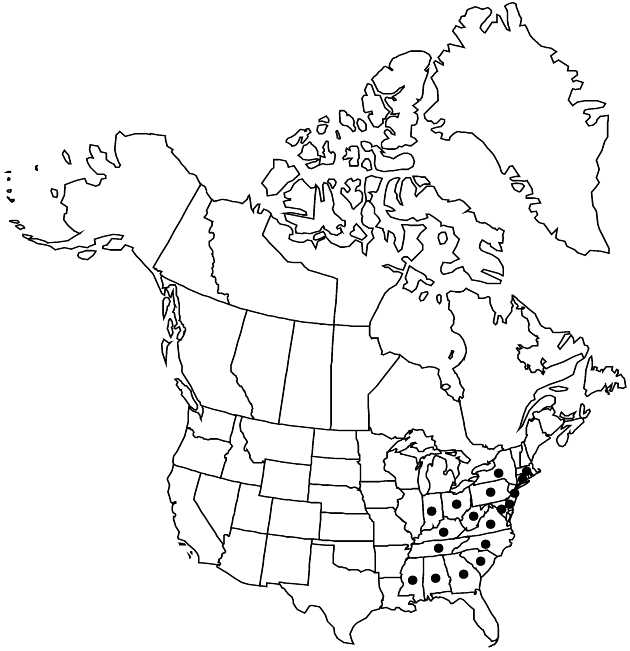Difference between revisions of "Solidago erecta"
Fl. Amer. Sept. 2: 542. 1813.
FNA>Volume Importer |
imported>Volume Importer |
||
| (4 intermediate revisions by 2 users not shown) | |||
| Line 8: | Line 8: | ||
}} | }} | ||
|common_names=Slender goldenrod | |common_names=Slender goldenrod | ||
| + | |special_status={{Treatment/ID/Special_status | ||
| + | |code=E | ||
| + | |label=Endemic | ||
| + | }} | ||
|basionyms= | |basionyms= | ||
|synonyms={{Treatment/ID/Synonym | |synonyms={{Treatment/ID/Synonym | ||
|name=Solidago porteri | |name=Solidago porteri | ||
|authority=Small | |authority=Small | ||
| + | |rank=species | ||
}} {{Treatment/ID/Synonym | }} {{Treatment/ID/Synonym | ||
|name=Solidago speciosa var. erecta | |name=Solidago speciosa var. erecta | ||
|authority=(Banks ex Pursh) MacMillan | |authority=(Banks ex Pursh) MacMillan | ||
| + | |rank=variety | ||
}} | }} | ||
|hierarchy=Asteraceae;Asteraceae tribe Astereae;Solidago;Solidago sect. Solidago;Solidago subsect. Squarrosae;Solidago erecta | |hierarchy=Asteraceae;Asteraceae tribe Astereae;Solidago;Solidago sect. Solidago;Solidago subsect. Squarrosae;Solidago erecta | ||
| Line 39: | Line 45: | ||
-->{{#Taxon: | -->{{#Taxon: | ||
name=Solidago erecta | name=Solidago erecta | ||
| − | |||
|authority=Banks ex Pursh | |authority=Banks ex Pursh | ||
|rank=species | |rank=species | ||
| Line 53: | Line 58: | ||
|publication title=Fl. Amer. Sept. | |publication title=Fl. Amer. Sept. | ||
|publication year=1813 | |publication year=1813 | ||
| − | |special status= | + | |special status=Endemic |
| − | |source xml=https:// | + | |source xml=https://bitbucket.org/aafc-mbb/fna-data-curation/src/2e0870ddd59836b60bcf96646a41e87ea5a5943a/coarse_grained_fna_xml/V19-20-21/V20_239.xml |
|tribe=Asteraceae tribe Astereae | |tribe=Asteraceae tribe Astereae | ||
|genus=Solidago | |genus=Solidago | ||
Latest revision as of 20:01, 5 November 2020
Plants 30–120 cm; caudices erect, branched, thick. Stems usually single, erect, essentially glabrous basally to hispidulo-puberulent in arrays. Leaves: basal and proximal cauline tapering to long, winged petioles (quickly reduced distally on stems), blades broadly oblanceolate to obovate, 40–150 × 15–50 mm, margins serrate, finely ciliate, apices acute to obtuse, faces glabrous; mid and distal cauline sessile, blades linear-elliptic, 5–50 × 2–10 mm, margins entire, finely ciliate. Heads 15–350 (1–10 per branch), clustered on short divergent lateral branches in elongate and usually narrowly paniculiform arrays, often interrupted proximally, not secund, sometimes with ascending, straight or arching, elongate branches (like main axis). Peduncles 1–3 mm. Involucres narrowly campanulate, 3.5–6.5 mm. Phyllaries in 3–5 series, appressed, strongly unequal, outer ovate, inner broadly oblong, obtuse to rounded, glabrous. Ray florets 5–9; laminae 2.5–3.5 × 0.7–1 mm. Disc florets commonly 6–10; corollas 4 mm, lobes ca. 1 mm. Cypselae (tan) ca. 2.5 mm, glabrous; pappi 3 mm. 2n = 18.
Phenology: Flowering Aug–Oct.
Habitat: Dry woods, disturbed open soils, road embankments
Elevation: 0–1000 m
Distribution

Ala., Conn., Del., Ga., Ind., Ky., Md., Mass., Miss., N.J., N.Y., N.C., Ohio, Pa., S.C., Tenn., Va., W.Va.
Discussion
Solidago erecta is mostly absent from the coastal plain in the southeastern United States.
Selected References
None.